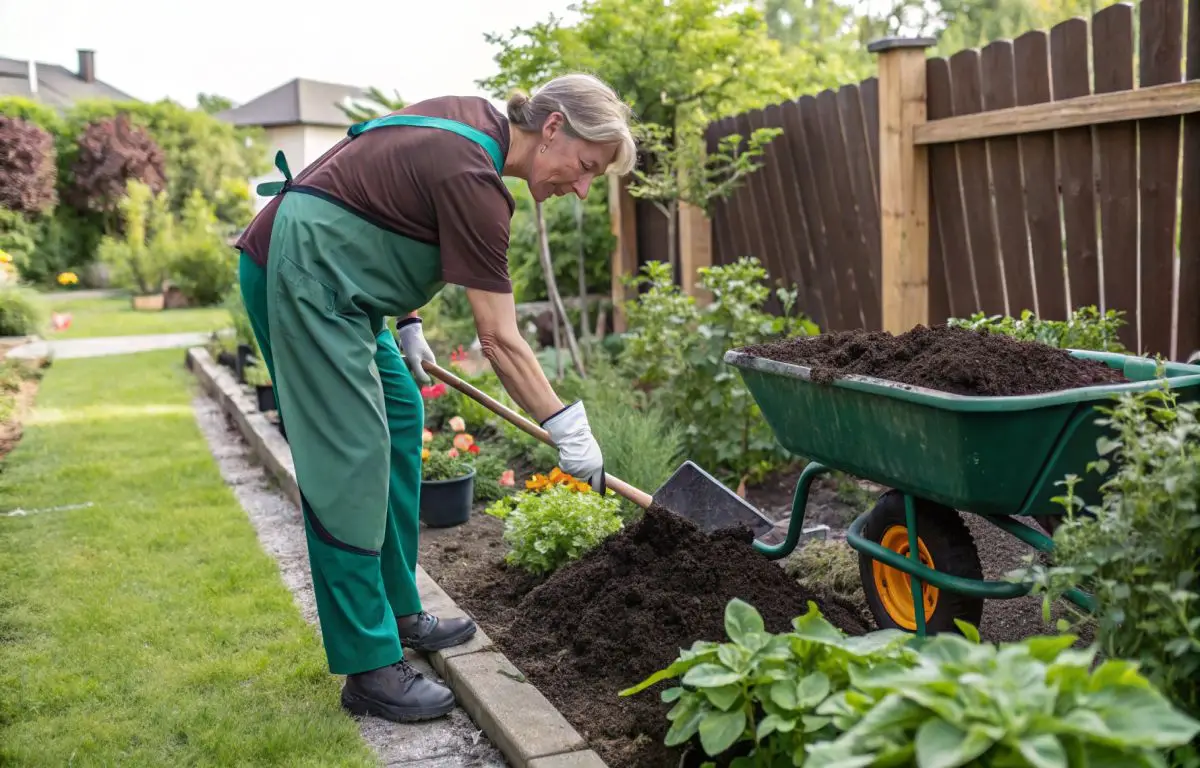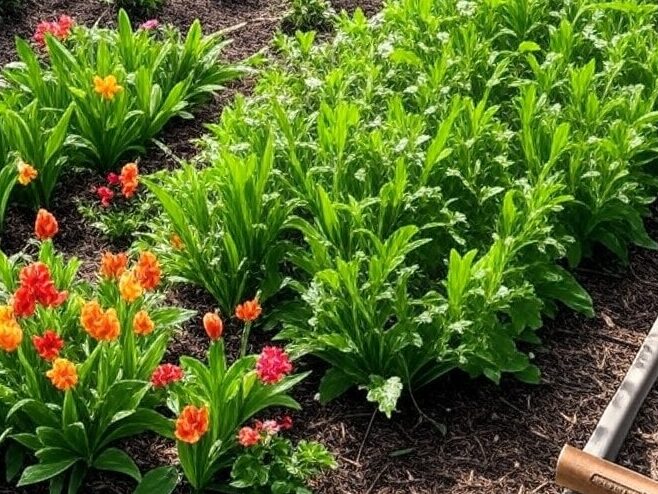Creating your own DIY garden bed on a budget is an excellent way to enjoy gardening without breaking the bank. Whether you’re a beginner or an experienced gardener, you can build a raised garden bed using affordable materials, ensuring it thrives while keeping costs low. In this article, we’ll guide you through building your garden bed, preparing the soil, choosing materials, and maintaining it year-round—with specific tips to save money and maximize results.
How to Build a Simple Raised DIY Garden Bed
Building a simple raised DIY garden bed is a great way to maximize your gardening space and improve soil conditions, especially in areas with poor soil quality. The best part? You can do it for under $40 with basic tools and materials.
Choosing the Right Location
The first step is picking a spot that gets 6–8 hours of sunlight daily—essential for most plants. In the Northern Hemisphere, a south-facing area works best. Avoid spots near large trees that cast shade or steal water. Look for a flat area with good drainage (test by pouring water; it should soak in within an hour). To save money, choose a location that needs minimal clearing—fewer rocks and roots mean less prep work.
Essential Tools and Materials Needed
You’ll need:
- Untreated wood (e.g., pine planks, $10-$15 for a 6-foot piece), concrete blocks ($1-$2 each), or recycled materials (free from salvage yards).
- Nails or screws ($5 for a small pack).
- Tools: A saw ($10-$20), hammer ($5), measuring tape ($3), and a level ($10—or borrow one).
Budget hack: Check local listings for free scrap wood or broken concrete blocks to cut costs further.
Step-by-Step Instructions for Assembling the Bed
- Measure: A 4×4-foot bed is ideal for beginners—small enough to manage, big enough for variety.
- Cut: For a 12-inch-high bed, cut two 6-foot pine planks into four 4-foot pieces and four 1-foot pieces.
- Assemble: Form a square, overlapping ends at the corners. Secure each corner with two 3-inch screws (pre-drill holes to avoid splitting cheap wood).
- Level: Place the frame in your spot and use a level to ensure it’s even—dig small trenches under high spots if needed.
- Weed Barrier: Lay free cardboard (from recycling) under the bed to smother grass and weeds.
Total cost: $20-$30 for wood and screws.
Tips for Filling with Quality Soil
For a thriving garden, layer 2 inches of gravel ($5 bag) at the bottom for drainage, then fill with a 40-40-20 mix: 40% compost ($5-$10 or free if homemade), 40% topsoil ($5 bag), and 20% peat moss or coconut coir ($5-$7). This costs about $15-$20 for a 4×4 bed and provides nutrients for strong plants. Save more by composting kitchen scraps (e.g., veggie peels, coffee grounds) and fallen leaves.
Top Materials to Use for a Durable Garden Bed
The materials you choose determine your bed’s longevity and effectiveness. Here are affordable, durable options with pros, cons, and costs.
Pros and Cons of Using Wood for Garden Beds
- Pine: Cheap ($1-$2 per linear foot), easy to work with, but lasts 3-5 years before rotting.
- Cedar: Naturally rot-resistant, lasts 10-15 years, but costs $3-$4 per foot.
Budget tip: Use untreated pine and plan to replace it—or seal it with non-toxic linseed oil ($5) to extend its life slightly.
Why Concrete Blocks Are a Long-Lasting Option
Concrete blocks ($1-$2 each) last 20+ years and stack easily for a 16-inch bed (8 blocks = $8-$16). They offer great drainage but retain heat, so avoid in scorching climates. Bonus: Hollow blocks can double as planters for herbs like basil.
Using Recycled Plastic Boards for Sustainability
Recycled plastic lumber ($5-$7 per 6-foot board) resists rot, needs no maintenance, and lasts 15-20 years. Find it at eco-friendly hardware stores or online. It’s pricier upfront but won’t leach chemicals like some treated woods might—an eco-win for budget gardeners.
Comparing Cost-Effectiveness of Different Materials
| Material | Initial Cost (4×4 Bed) | Lifespan | Best For |
|---|---|---|---|
| Untreated Pine | $10-$20 | 3-5 years | Tight Budgets |
| Cedar | $30-$50 | 10-15 years | Long-Term Use |
| Concrete Blocks | $15-$25 | 20+ years | Durability |
| Recycled Plastic | $40-$60 | 15-20 years | Sustainability |
Essential Tips for Preparing the Soil in Your Garden Bed

Proper soil prep is the key to success. Here’s how to create the perfect foundation affordably.
How to Test and Adjust Soil pH
Most veggies thrive at a pH of 6-7 (slightly acidic). Test with a $10 kit from a garden center—or try this hack: Mix soil with vinegar (fizzes = alkaline) or baking soda (fizzes = acidic). Adjust by adding 1 pound of lime ($5 bag) per 100 square feet to raise pH by 1 point, or sulfur ($5) to lower it.
The Importance of Adding Organic Compost
Compost boosts nutrients and cuts fertilizer costs by 50%. Make your own: Mix 1 part kitchen scraps (e.g., peels, eggshells), 2 parts dry leaves, and a handful of soil. Turn weekly; it’s ready in 2-3 months. A 4×4 bed needs about 2 cubic feet ($5 if bought).
Creating the Perfect Soil Mix for Vegetables
Combine 40% garden soil, 40% compost, and 20% peat moss with a handful of sand ($3 bag) for drainage. For tomatoes, add extra compost; for carrots, more sand for loose soil. If it’s too dense, mix in perlite ($5 bag) to lighten it.
Preventing Drainage Problems
Before filling, test drainage: Dig a hole, fill with water, and check if it drains in 1-2 hours. If not, add 2-3 inches of gravel or small rocks (free from a driveway or $5 bag). This prevents root rot and keeps plants happy.
Creative DIY Garden Bed Ideas for Small Spaces
Even with limited space, you can grow a productive garden on a budget. Try these ideas.
Designing Vertical Planters for Limited Areas
Stack three $5 wooden crates (or free pallets), drill drainage holes, and line with landscape fabric ($5 roll). Mount on a wall or fence—perfect for herbs like mint or small veggies like lettuce. Total cost: $15-$20.
Using Tiered Beds for Maximum Planting Space
Build a three-tier bed: 4×4, 3×3, and 2×2 feet, using scrap wood ($0-$25). Stack with deeper soil at the bottom for root crops (carrots) and shallow soil up top for herbs. This triples your planting area in a 4×4 footprint.
Incorporating Recycled Materials into Garden Beds
Stack two old tires (free from garages), paint them ($5 can), and fill with soil for a quirky potato bed. Or use wooden crates ($0-$5) as mini beds. This cuts costs and adds charm.
Customizing Beds for Balconies and Patios
For a balcony, drill holes in a $10 plastic storage bin, add scrap-wood legs, and fill for a 2×1-foot bed (under 50 pounds for safety). Grow compact plants like cherry tomatoes or spinach. Total cost: $15-$20.
How to Maintain Your DIY Garden Bed Year-Round

Proper care keeps your garden thriving affordably all year.
Seasonal Planting and Rotation Tips
Rotate crops to avoid soil depletion: Spring (peas—adds nitrogen), Summer (tomatoes—uses nitrogen), Fall (kale—light feeder). Plan ahead for fresh produce and fewer pests—all for the cost of seeds ($1-$3 per pack).
Protecting Your Garden Bed During Winter
In cold climates, cover with 2-3 inches of mulch (free leaves or $5 straw bale) or an old shower curtain ($0) as a frost shield. Stack free branches around the edges as a windbreak. Your bed will be spring-ready.
How to Mulch for Weed Prevention and Moisture Retention
Spread 2-3 inches of straw ($5 bale) or dried grass clippings (free—let them dry to avoid rot) around plants. This cuts watering by 30%, prevents weeds, and keeps soil temps steady.
With these tips, building and maintaining a garden bed on a budget is simple and rewarding. A 4×4 bed can cost as little as $30-$40 total—wood ($15), soil ($15), gravel ($5)—and yield fresh veggies all season. Happy gardening!
FAQs
What materials are best for building a DIY garden bed on a budget?
Pine ($10-$20) is cheapest, concrete blocks ($15-$25) are durable, and recycled plastic ($40-$60) is sustainable. Pick based on your budget and timeline.
How can I prepare soil for my DIY garden bed?
Test pH with a $10 kit, adjust with lime or sulfur ($5 each), and mix 40% compost, 40% soil, 20% peat moss plus sand ($15-$20 total).
What are some creative ideas for small garden spaces?
Try vertical crate planters ($15), tiered scrap-wood beds ($0-$25), or tire beds (free with $5 paint).
How can I maintain my garden bed year-round?
Rotate crops (e.g., peas, tomatoes, kale), mulch with free leaves, and cover with a $0 shower curtain in winter.
What are the benefits of building a raised garden bed?
Better soil control, improved drainage, fewer pests, and easier access—plus, a 4×4 bed can grow $50-$100 worth of veggies yearly.
People Also Read:
